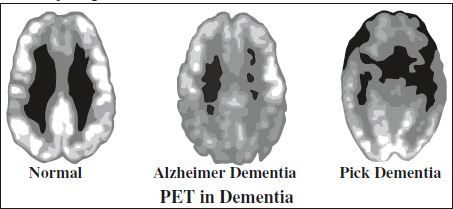Differential Diagnosis of Nervous System Disorders
= acquired progressive global impairment of intellectual functioning
Prevalence: 35 million worldwide; rising due to increase in life expectancy; in USA 14% of population >65 years of age and >50% of individuals >85 years
Dx: multiple cognitive deficits representing a decrease from baseline + interfering with social / professional function including impairment of (1) memory (2) motor activity (3) recognition (4) executive function
Etiology: may be caused by more than 80 diseases
- CORTICAL
- Alzheimer disease
- Pick disease = frontotemporal dementia
- Mild cognitive impairment
- Creutzfeldt-Jakob disease
- SUBCORTICAL
- Vascular dementia: multi-infarct, Binswanger, CADASIL = cerebral autosomal dominant arteriopathy with subcortical infarcts and leukoencephalopathy)
- Dementia with Lewy bodies
- Huntington disease
- Parkinson disease
- Wernicke-Korsakoff syndrome
- Wilson disease
- Multiple sclerosis
- Infectious etiology (HIV, Lyme disease, syphilis)
- Dementia syndrome of depression
- OTHERS
- MELAS
- Cortical venous thrombosis
- Normal pressure hydrocephalus
- Subdural hematoma
- Brain mass (CNS lymphoma + other neoplasms)
In order of frequency:
- Alzheimer disease 60–70%
- Dementia with Lewy bodies 25%
- Frontotemporal dementia 5–10%
- Vascular dementia ?% (declining)
- Mixed etiology 6%
- Normal pressure hydrocephalus 1%
- Depression 1%
- Tumor 1%
PET in Dementia
- PET is replacing SPECT ← (1) better spatial resolution, (2) greater sensitivity for hypometabolism compared to perfusion and (3) ability to quantify changes!
Rationale: dementia diminishes the usually high metabolic rate of active neurons in a typical pattern of distribution
Indication: distinguish between Alzheimer disease and frontotemporal (Pick) dementia
Requirements for PET imaging:
- >6 months of progressive dementia
- Comprehensive neurological exam
- Diagnostic criteria for dementia have been met
- sparing of sensorimotor cortex
